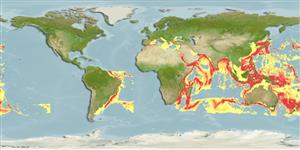Common names from other countries
Environment: milieu / climate zone / depth range / distribution range
Écologie
; saumâtre; profondeur 0 - 4177 m (Ref. 107353). Tropical
Circumglobal.
Length at first maturity / Taille / Poids / Âge
Maturity: Lm ? range ? - ? cm Max length : 3.0 cm WD mâle / non sexé; (Ref. 7493)
Intertidal (Ref. 81522); Littoral to sublittoral fringe areas; known as a fouling species (Ref. 81749) - on piers, pontoons, and boat hulls (Ref. 102838). In sheltered (Ref. 125338) to exposed rocky shores. Can be found on the shells of predatory gastropods Reishia clavigera and Cellana toreuma (Ref. 127116). Part of both epibenthic and arboreal communities in mangrove areas (Ref. 128397). Sessile suspension feeder (Ref. 125928).
Life cycle and mating behavior
Maturité | Reproduction | Frai | Œufs | Fécondité | Larves
Members of the superorder Thoracica are mostly hermaphroditic. Broadcast spawners, fertilization occurs in the mantle cavity. Life cycle: Eggs hatch into planktonic nauplii and leave the mantle cavity. Afterwards, they undergo six naupliar instars succeded by nonfeeding cypris larva (settling stage) which later metamorphose into adults.
Paulay, G. and A. Ross. 2003. (Ref. 7493)
Statut dans la liste rouge de l'IUCN (Ref. 130435)
statut CITES (Ref. 108899)
Not Evaluated
Not Evaluated
Utilisations par l'homme
| FishSource |
Outils
Sources Internet
Estimates based on models
Preferred temperature
(Ref.
115969): 2.8 - 13.7, mean 4.5 (based on 1972 cells).
Résilience
Haut, temps minimum de doublement de population inférieur à 15 mois (K=0.44-0.47).
Vulnérabilité
Low vulnerability (10 of 100).
Catégorie de prix
Unknown.
